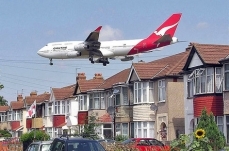Urbanization (main)
From The Encyclopedia of Earth
Urbanization
-
 Featured Article
Featured Article  Pandemic Influenza: A 21st Century Urban...This Policy Review article written by David M. Bell, Isaac B. Weisfuse, Mauricio Hernandez-Avila, Carlos del Rio, Xinia Bustamante, and Guenael Rodier*, appeared first in... More »
Pandemic Influenza: A 21st Century Urban...This Policy Review article written by David M. Bell, Isaac B. Weisfuse, Mauricio Hernandez-Avila, Carlos del Rio, Xinia Bustamante, and Guenael Rodier*, appeared first in... More »
-
 Featured Article
Featured Article  City Life May Alter Green AttitudesStudy of Chinese citizens says jobs more important than salary when it comes to pro-environmental behavior View a video interview with sustainability scientist Jianguo... More »
City Life May Alter Green AttitudesStudy of Chinese citizens says jobs more important than salary when it comes to pro-environmental behavior View a video interview with sustainability scientist Jianguo... More »
-
 Featured News Article
Featured News Article  Climate Change and Unprepared CitiesClimate Change Poses Major Risks for Unprepared Cities Fast-growing urban areas most likely to feel the heat Cities worldwide are failing to take necessary steps to protect... More »
Climate Change and Unprepared CitiesClimate Change Poses Major Risks for Unprepared Cities Fast-growing urban areas most likely to feel the heat Cities worldwide are failing to take necessary steps to protect... More »
-
 Featured Article
Featured Article  Noise pollution (Urbanization)Noise pollution is unwanted or harmful sound that intrudes upon human or other faunal activity. Noise pollution is almost entirely human generated, whether by machine sources... More »
Noise pollution (Urbanization)Noise pollution is unwanted or harmful sound that intrudes upon human or other faunal activity. Noise pollution is almost entirely human generated, whether by machine sources... More »
-
 Featured Article
Featured Article  Geophony, Biophony, and AnthrophonyWhat do these words mean? Biophony is the melodic sound created by such organisms as frogs and birds; geophony, the composition of non-biological sounds like wind, rain and... More »
Geophony, Biophony, and AnthrophonyWhat do these words mean? Biophony is the melodic sound created by such organisms as frogs and birds; geophony, the composition of non-biological sounds like wind, rain and... More »
Recently Updated
 Population-environment theory and contemporary applications Last Updated on 2014-07-24 15:49:49 Introduction Humans have sought to understand the relationship between population dynamics and the environment since the earliest times (1-3), but it was Thomas Malthus’ Essay on the Principle of Population in 1798 that is credited with launching the study of population and resources as a scientific topic of inquiry. Malthus’ famous hypothesis was that population numbers tend to grow exponentially while food production grows linearly, never quite keeping pace with population and thus resulting in natural “checks” (such as famine) to further growth. Although the subject was periodically taken up again in the ensuring decades, it wasn’t until the 1960s that significant research interest was rekindled. In 1963 the U.S. National Academy of Sciences published The Growth of World Population, a report that reflected scientific concern about the consequences of... More »
Population-environment theory and contemporary applications Last Updated on 2014-07-24 15:49:49 Introduction Humans have sought to understand the relationship between population dynamics and the environment since the earliest times (1-3), but it was Thomas Malthus’ Essay on the Principle of Population in 1798 that is credited with launching the study of population and resources as a scientific topic of inquiry. Malthus’ famous hypothesis was that population numbers tend to grow exponentially while food production grows linearly, never quite keeping pace with population and thus resulting in natural “checks” (such as famine) to further growth. Although the subject was periodically taken up again in the ensuring decades, it wasn’t until the 1960s that significant research interest was rekindled. In 1963 the U.S. National Academy of Sciences published The Growth of World Population, a report that reflected scientific concern about the consequences of... More »  Ecosystems and Human Well-Being: Volume 1: Current State and Trends: Urban Systems Last Updated on 2014-06-28 17:05:25 This is Chapter 27 of the Millenium Ecosystem Assessment report Ecosystems and Human Well-Being: Volume 1: Current State and Trends Coordinating Lead Authors: Gordon McGranahan, Peter Marcotullio Lead Authors: Xuemei Bai, Deborah Balk, Tania Braga, Ian Douglas, Thomas Elmqvist, William Rees, David Satterthwaite, Jacob Songsore, Hania Zlotnik Review Editors: Jerry Eades, Exequiel Ezcurra Main Messages Urbanization and urban growth continue to be major demographic trends. The world’s urban population increased from about 200 million (~15% of world population) in 1900 to 2.9 billion (~50% of world population) in 2000, and the number of cities with populations in excess of 1 million increased from 17 in 1900 to 388 in 2000. As people are increasingly living in cities, and as cities act as both human ecosystem habitats and drivers of ecosystem change, it will become increasingly... More »
Ecosystems and Human Well-Being: Volume 1: Current State and Trends: Urban Systems Last Updated on 2014-06-28 17:05:25 This is Chapter 27 of the Millenium Ecosystem Assessment report Ecosystems and Human Well-Being: Volume 1: Current State and Trends Coordinating Lead Authors: Gordon McGranahan, Peter Marcotullio Lead Authors: Xuemei Bai, Deborah Balk, Tania Braga, Ian Douglas, Thomas Elmqvist, William Rees, David Satterthwaite, Jacob Songsore, Hania Zlotnik Review Editors: Jerry Eades, Exequiel Ezcurra Main Messages Urbanization and urban growth continue to be major demographic trends. The world’s urban population increased from about 200 million (~15% of world population) in 1900 to 2.9 billion (~50% of world population) in 2000, and the number of cities with populations in excess of 1 million increased from 17 in 1900 to 388 in 2000. As people are increasingly living in cities, and as cities act as both human ecosystem habitats and drivers of ecosystem change, it will become increasingly... More »  Africa collection: Population Last Updated on 2013-09-03 12:19:22 Human well-being and livelihoods in Africa Empowering people and institutions in Africa: institutional and governance interlinkages Return to the Africa Collection More »
Africa collection: Population Last Updated on 2013-09-03 12:19:22 Human well-being and livelihoods in Africa Empowering people and institutions in Africa: institutional and governance interlinkages Return to the Africa Collection More »  Urban yards as birds' refuges Last Updated on 2012-08-23 00:00:00 Urban yards with plants that mimic native vegetation offer birds "mini-refuges" and help to offset losses of biodiversity in cities,. Such purposeful landscaping with native vegetation helps local bird species. Native Plants in Urban Yards Offer Birds "Mini-Refuges" Yards with plants that mimic native vegetation offer birds "mini-refuges" and help to offset losses of biodiversity in cities, according to results of a study published in the journal PLOS ONE. "Native" yards support birds better than those with traditional grass lawns and non-native plantings. Researchers conducted the study through the National Science Foundation's (NSF) Central Arizona-Phoenix Long-Term Ecological Research (LTER) site, one of 26 such sites around the globe in ecosystems from coral reefs to deserts, from forests to grasslands. "To a... More »
Urban yards as birds' refuges Last Updated on 2012-08-23 00:00:00 Urban yards with plants that mimic native vegetation offer birds "mini-refuges" and help to offset losses of biodiversity in cities,. Such purposeful landscaping with native vegetation helps local bird species. Native Plants in Urban Yards Offer Birds "Mini-Refuges" Yards with plants that mimic native vegetation offer birds "mini-refuges" and help to offset losses of biodiversity in cities, according to results of a study published in the journal PLOS ONE. "Native" yards support birds better than those with traditional grass lawns and non-native plantings. Researchers conducted the study through the National Science Foundation's (NSF) Central Arizona-Phoenix Long-Term Ecological Research (LTER) site, one of 26 such sites around the globe in ecosystems from coral reefs to deserts, from forests to grasslands. "To a... More »  Geophony, Biophony, and Anthrophony Last Updated on 2012-08-09 00:00:00 What do these words mean? Biophony is the melodic sound created by such organisms as frogs and birds; geophony, the composition of non-biological sounds like wind, rain and thunder; and anthrophony, the conglomeration of noise spawned by human activity. Studying Nature's Rhythms: Soundscape Ecologists Spawn New Field The following Discovery article is part is part four in a series on the National Science Foundation's Science, Engineering and Education for Sustainability (SEES) investment. Visit parts one, two, three, five, six and seven in this series. Listen to biophony, geophony, anthrophony: the 'music' of Planet Earth The following is part four in a series on the National Science Foundation's Science, Engineering and Education for Sustainability (SEES) investment. Visit parts one, two, three, five, six and seven in this series. Geophony.... More »
Geophony, Biophony, and Anthrophony Last Updated on 2012-08-09 00:00:00 What do these words mean? Biophony is the melodic sound created by such organisms as frogs and birds; geophony, the composition of non-biological sounds like wind, rain and thunder; and anthrophony, the conglomeration of noise spawned by human activity. Studying Nature's Rhythms: Soundscape Ecologists Spawn New Field The following Discovery article is part is part four in a series on the National Science Foundation's Science, Engineering and Education for Sustainability (SEES) investment. Visit parts one, two, three, five, six and seven in this series. Listen to biophony, geophony, anthrophony: the 'music' of Planet Earth The following is part four in a series on the National Science Foundation's Science, Engineering and Education for Sustainability (SEES) investment. Visit parts one, two, three, five, six and seven in this series. Geophony.... More »